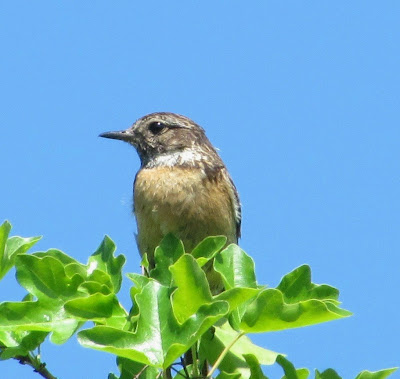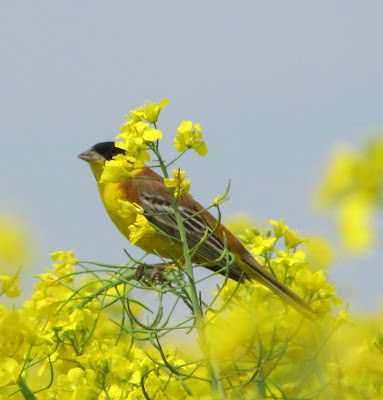 |
| the start of the forest as seen from near my village |
I have little experience as a woodland birder but I'm learning fast. In Libya there was very little woodland and before that in Azerbaijan most of it was upland and in militarised areas.
inside the forest
I realise how important knowing your bird songs is. I know too few! However I can tell you the forest between my village and Oreshak was far from quiet. The most common bird here is probably chaffinch whose song I have learnt to recognise. I also saw a few of them! Nightingale were common in the better lit areas. Certainly there were golden oriole, another bird I can recognise by sound. There were great tit too more often near the few pine trees.
female blackbird yesterday
The collins guide describes blackbird as confiding. This is an anglo-centric view of the world. It may be confiding if regularly fed in British gardens but in Bulgaria this bird is shy - or at least it has been with me. In woodland I occasionally catch glimpses of them but finally yesterday one perched long enough and close enough for me to get a good look albeit against a backcloth of shafts of sun gleaming through the trees. Turtle dove is not confiding anywhere and they were only seen by me when they decided to move off, typically many metres before I walked near them!
medium sized egg (blackbird?)
When I was very young, a long time ago, bird books would always include pictures of eggs. Now they never do. In the bad old days egg collecting was a hobby in its own right. Now of course we know better. I saw this one on a narrow track in the forest. It looks like it got on the ground by natural causes. Certainly all the contents have disappeared presumably eaten. The egg was roughly 2/3 to 3/4 the length of a chicken egg. A quick look at google images and I think it could be a blackbird egg. If not the bird must be a similar size.
short toed treecreeper
I had hoped to see woodpeckers. Somehow this time they evaded me. However I was delighted to spot a short toed treecreeper and even get some sort of picture. I was attracted by a single repeated note and the vague notion that I had seen some movement in the wood.
I am confident it is a short toed treecreeper for two reasons. First was the single note. The (Eurasian) treecreeper makes a more complex buzzing sound apparently. Second the distribution maps tell me it the only one in my area. Now when I was birding in Libya the distribution maps in the guides were very wrong usually due to under-reporting but I am told they are more accurate here.
Nearer the edges of the wood were nesting starling (especially close to the stream at the Oreshak end). greenfinch and woodlark.
woodlark up a tree
One woodlark took evasive action when I walked towards him (without knowing it) and flew up into a tree. This behaviour is almost unique to a woodlark among European larks.
Hermann's tortoise
Every time I go into Batova forest I see new wildlife. This time it was a very large (i.e mature) tortoise. Even armed with my "Amphibians and Reptiles of Bulgaria" back home I couldn't split it between Hermann's and Mediterranean spur thighed. I didn't look at its thighs! The book says Hermann's is a much more of a forest tortoise hence the tentative identification.
red backed shrike at Oreshak
At Oreshak the far side of my forest walk, I was suddenly aware of the bright sun light. It's a beautiful spot where the forest stream comes out into the light. Here were corn bunting, red-backed shrike, starling and plenty of bee-eater.
skylark clinging on to a rape plant on a gust of wind
After five hours there and back I returned to my village side of the forest passing by rape and wheat fields. A common quail bolted into the wheat field from the edge of the path. This is the first time I have seen one in Bulgaria. Common swift were flying overhead in a completed different manner to skylark which were also present. Yellow wagtail were also peppering the path. Now I know where most of them in my area hang out. Black headed bunting seem to love perching on top of rape plants. Lesser grey shrike and corn bunting were on the telephone wires as I got closer to the village.
starling in newly cut field
The journey ended back at the cut field on the village edge which I blogged about last time. The starling, yellow wagtail, corn bunting, black headed bunting and skylark were there again. Once again house martin and barn swallow flew over. No sign of turtle dove, white wagtail and kestrel this time. However there were red-rumped swallow flying overhead, pigeon on the field with magpie and yellow legged gull making brief appearances to more than compensate.




















































